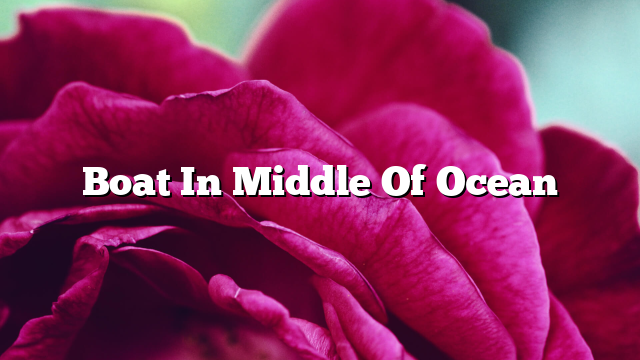Imagine standing on the deck of a small boat, surrounded by endless stretches of deep blue ocean as far as the eye can see. The gentle rocking of the waves beneath you creates a sense of both excitement and trepidation. You are alone, just you and the vast expanse of water, with no land in sight. The boat becomes your sanctuary, your only connection to the outside world. In this moment, you are reminded of the powerful forces of nature and the fragile nature of human existence. Welcome to the captivating world of the boat in the middle of the ocean.
In this article, we will delve into the intricacies of this unique setting and explore the feelings and experiences that come with being adrift at sea. From the solitude and isolation to the awe-inspiring beauty and the constant battle against the elements, we will uncover the realities of life on a boat in the middle of the ocean. Join us as we navigate through the unknown, where the deep blue becomes both a playground and a source of uncertainty, and where the boat itself becomes a symbol of resilience and adaptability.
Boat in Middle of Ocean: A boat in the middle of the ocean signifies being far away from land and surrounded by water. It can be a symbol of adventure, exploration, and solitude. Whether you’re dreaming of sailing across the open sea or wondering about the concept, a boat in the middle of the ocean evokes a sense of freedom and the vastness of the world’s waters.
Introduction
Have you ever wondered what it would be like to be in a boat in the middle of the ocean? It’s a unique and exhilarating experience that can offer a sense of freedom and solitude like no other. In this article, we will guide you through the step-by-step process of navigating a boat in the vast expanse of the ocean, ensuring your safety and enjoyment throughout the journey.
Step 1: Prepare Yourself and the Boat
Before setting sail, it is crucial to ensure that both you and the boat are well-prepared for the journey. Start by checking the weather forecast to ensure favorable conditions. Gather all the necessary safety equipment, including life jackets, flares, and a first aid kit. Inspect the boat for any signs of damage or malfunction and make sure all essential systems are in working order, such as the engine, navigation lights, and radio communication.
Next, plan your route and familiarize yourself with the navigational charts and markers. Identify any potential hazards or restricted areas along the way. Inform someone on land about your trip, providing them with your planned route and estimated time of return. This precaution will ensure that someone can raise the alarm if you encounter any difficulties.
Step 2: Navigate and Stay on Course
Once you are out on the water, it is essential to navigate effectively and stay on course. Use a compass or GPS system to determine your heading and regularly check your position on the charts. Maintain a safe distance from other boats or maritime traffic and be aware of any navigational aids, such as buoys or lighthouses, that can guide you along your route.
Keep a vigilant eye on the horizon for any changes in weather or sea conditions. Sudden storms or strong currents can pose a significant risk, so be prepared to alter your course or seek shelter if necessary. Continuously monitor the radio for any updates or warnings from the coastguard or other vessels in the area.
Step 3: Ensure Safety and Enjoyment
Safety should always be your top priority when boating in the middle of the ocean. Always wear a life jacket and ensure that everyone on board does the same. Avoid alcohol consumption, as it impairs judgment and reaction times. Stay hydrated and protect yourself from the sun by wearing sunscreen and a hat.
While safety is paramount, don’t forget to enjoy the experience! Take the time to appreciate the vastness of the ocean, the beauty of the surrounding nature, and the serenity of being far away from the hustle and bustle of everyday life. Capture these moments with a camera or simply take mental snapshots to cherish for a lifetime.
Step 4: Prepare for Emergencies
Despite all precautions, emergencies can still occur while boating in the open ocean. It is crucial to be prepared for such situations. Ensure that you have a working radio or satellite phone to call for help if needed. Familiarize yourself with basic first aid techniques, including CPR and treating injuries.
Additionally, consider investing in an emergency beacon or an EPIRB (Emergency Position-Indicating Radio Beacon) that can transmit your location to rescue services in case of an emergency. Practice using these devices before setting sail to ensure you know how they work.
Step 5: Continuously Learn and Improve
Boating in the middle of the ocean is a skill that requires continuous learning and improvement. Take courses and workshops to enhance your knowledge of navigation, weather patterns, and emergency procedures. Stay up to date with the latest safety regulations and recommendations.
Connect with other boaters and participate in online forums or local boating clubs to share experiences and learn from seasoned sailors. The more you educate yourself and gain practical experience, the more confident and capable you will become in navigating a boat in the middle of the ocean.
Frequently Asked Questions
Here are some commonly asked questions about being stranded on a boat in the middle of the ocean.
Question 1: How do people get stranded in the middle of the ocean?
There are various reasons why someone may find themselves stranded in the middle of the ocean. It could be due to a boating accident, a shipwreck, or even getting lost at sea. In some cases, adverse weather conditions or equipment failure can also lead to being stranded.
It’s crucial to be prepared for such situations by having proper safety equipment, navigation tools, and knowledge of emergency protocols.
Question 2: What should I do if I find myself stranded on a boat in the middle of the ocean?
If you find yourself stranded on a boat in the middle of the ocean, the first step is to remain calm and assess the situation. Check your surroundings for any potential hazards or signs of land nearby.
Contact emergency services or use any communication devices you have on board to alert others about your situation. It’s also essential to conserve your resources, such as food, water, and fuel, until help arrives.
Question 3: How long can someone survive stranded on a boat in the middle of the ocean?
The duration of survival depends on several factors, including access to resources, weather conditions, and individual resilience. Generally, a person can survive without food for several weeks, but without water, survival is limited to just a few days.
It’s crucial to have emergency supplies, such as fresh water, non-perishable food, and first aid kits, on board. Additionally, seeking immediate assistance and staying positive can significantly increase the chances of survival.
Question 4: Are there any dangers or risks while being stranded on a boat in the middle of the ocean?
Yes, there are several dangers and risks associated with being stranded on a boat in the middle of the ocean. These include extreme weather conditions, lack of drinking water, exposure to the sun and elements, and potential encounters with marine predators.
It’s essential to prioritize safety and take necessary precautions, such as wearing life jackets, using sunscreen, and staying hydrated. Seeking shelter from the sun and maintaining a positive mindset can also help mitigate these risks.
Question 5: How can I increase my chances of being rescued when stranded on a boat in the middle of the ocean?
To increase your chances of being rescued when stranded on a boat in the middle of the ocean, there are several actions you can take. First, activate any distress signals or emergency beacons you have on board. These signals can alert nearby vessels or aircraft to your location.
Additionally, try to attract attention by using flares, mirrors, or any other visible signals. Keeping a lookout for passing ships or aircraft and attempting to establish communication with them can also help in getting rescued. It’s important to remain hopeful and patient during the rescue process.
In conclusion, being in a boat in the middle of the ocean is an experience that truly captivates the soul and ignites a sense of adventure. The vastness of the ocean, stretching as far as the eye can see in all directions, evokes a feeling of both awe and insignificance. It is a reminder of the immense power and mystery of nature, as well as our own vulnerability in the face of its vastness.
Moreover, being surrounded by nothing but water and sky, with no land in sight, provides a unique opportunity for introspection and self-discovery. In the middle of the ocean, one can disconnect from the noise and distractions of everyday life and truly immerse oneself in the present moment. The rhythmic sound of the waves, the gentle rocking of the boat, and the endless expanse of blue can help clear the mind and foster a deep sense of peace and tranquility.
In essence, being in a boat in the middle of the ocean is a transformative experience that allows us to connect with nature in a profound way. It reminds us of our place in the world and teaches us humility, while also offering a space for personal reflection and rejuvenation. So, if you ever get the chance, set sail and embark on this remarkable journey – you may just discover a whole new world within yourself.


















